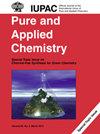通过调节有机填料的间距和聚乳酸的结晶度,研究纳米填料的组成和性质对提高聚乳酸纳米生物复合膜的机械和流变特性的影响
IF 2
4区 化学
Q3 CHEMISTRY, MULTIDISCIPLINARY
引用次数: 0
摘要
本研究探讨了基于聚乳酸(PLA)的纳米生物复合材料的形态以及各种热、机械和流变特性。本研究的目的是通过研究含有不同水平制备填料的聚乳酸/Mag-CTA 和聚乳酸/CMC 纳米生物复合材料的特性,评估改性阿尔及利亚粘土作为纳米填料的潜力。本研究采用两种不同的催化剂和在溶液中生产的有机增强剂,合成聚乳酸/麦饭石-CTA(PLA/Mag-CTA)和聚乳酸/微晶纤维素(CMC)纳米生物复合材料。所采用的各种技术的结果表明,聚乳酸纳米生物复合材料呈现出混合形态,包括插层和剥离。所采用的各种技术的结果表明,所开发的聚乳酸纳米生物复合材料具有夹层-剥离混合形态。在各种材料的生产过程中,Maghnite-CTA 填料和微晶纤维素的分散性得到了提高,同时也出现了高水平的聚集体。有机填料用量少时,流变性能最佳,达到了纳米填料的最佳分散状态。加入这两种纳米填料后,热行为特性明显增强。立体排阻色谱分析显示,纳米生物复合材料合成中使用的填料增加了聚乳酸链的平均分子量,而多分散指数保持不变。本文章由计算机程序翻译,如有差异,请以英文原文为准。
The impact of nanofiller composition and nature on the enhancement of mechanical and rheological properties of poly(lactic acid) (PLA) nanobiocomposite films is achieved by regulating the spacing of organic fillers and PLA crystallinity
This study examines the morphology and various thermal, mechanical, and rheological properties of polylactic acid (PLA)-based nanobiocomposites. The objective of this investigation is to evaluate the potential of modified Algerian clay as a nanofiller through an examination of the characteristics of PLA/Mag-CTA and PLA/CMC nanobiocomposites with varying levels of prepared fillers. This study is concerned with the synthesis of poly(lactic acid)/Maghnite-CTA (PLA/Mag-CTA) and poly(lactic acid)/microcrystalline cellulose (CMC) nanobiocomposites, with two distinctive catalysts and organic reinforcements produced in solution. The outcomes of the various techniques employed demonstrate that PLA nanobiocomposites exhibit a mixed morphology, comprising intercalation and exfoliation. The results from the diverse techniques used show that the PLA nanobiocomposites developed have a mixed intercalated-exfoliated morphology. The dispersion of the Maghnite-CTA filler and microcrystalline cellulose was enhanced during the production of the various materials, as well as the presence of aggregates at high levels. The best rheological performance, corresponding to the optimal dispersion of the nanofiller, was observed for a low quantity of organic filler. Thermal behavior properties were significantly enhanced with the incorporation of the two nanofillers. Analysis by steric exclusion chromatography showed that the fillers used in the nanobiocomposite synthesis increased the average molecular weights of the PLA chains, while the polydispersity index remained constant.
求助全文
通过发布文献求助,成功后即可免费获取论文全文。
去求助
来源期刊

Pure and Applied Chemistry
化学-化学综合
CiteScore
4.00
自引率
0.00%
发文量
60
审稿时长
3-8 weeks
期刊介绍:
Pure and Applied Chemistry is the official monthly Journal of IUPAC, with responsibility for publishing works arising from those international scientific events and projects that are sponsored and undertaken by the Union. The policy is to publish highly topical and credible works at the forefront of all aspects of pure and applied chemistry, and the attendant goal is to promote widespread acceptance of the Journal as an authoritative and indispensable holding in academic and institutional libraries.
 求助内容:
求助内容: 应助结果提醒方式:
应助结果提醒方式:


